Letters from Lodi
An insightful and objective look at viticulture and winemaking from the Lodi
Appellation and the growers and vintners behind these crafts. Told from the
perspective of multi-award winning wine journalist, Randy Caparoso.
What is Lodi terroir? (Part 4, How terroir focused wines are made)
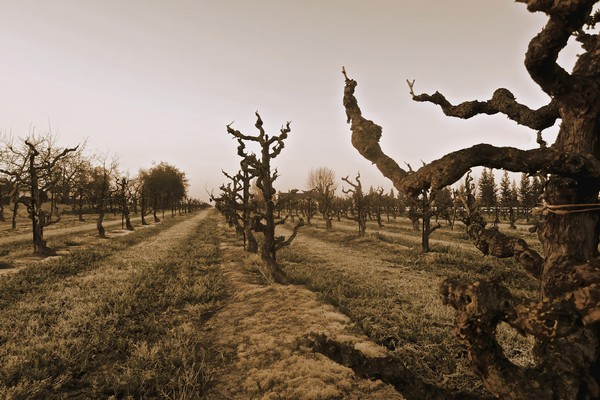
Marisa Vineyard, an old vine Mokelumne River-Lodi growth now bottled as a minimal intervention, terroir focused Zinfandel by Klinker Brick Winery, in sharp contrast with the brand's nationally distributed commercial style bottlings emphasizing varietal rather than character.
Continued from What is Lodi terroir? (part 3, Soil and topography)
The difference between commercial and terroir focused styles of varietals
Terroir focused wines are wines that are meant to taste like the vineyards or regions where they are grown more than anything else. Commercial style wines, on the other hand, are produced primarily to express...
• Varietal character (i.e., the tastes commonly associated with grape varieties that might be identified on a label), or
• Brand styles (many producers hang their hat on consistent sensory qualities associated with their brand).
Which, however, is not to say that terroir focused Mokelumne River-Lodi AVA Zinfandels, for example, do not also taste like a "Zinfandel." It's just that they taste like Zinfandels that could only come from Lodi's Mokelumne River appellation.

Foot treading of Lodi fruti: A more gentle, old school style of grape crushing possible in small, handcraft wineries.
Most Lodi Zinfandels, in fact, are not concerned with terroir. They taste like what most consumers expect out of any commercial Zinfandel: A berryish aroma and taste, fairly full body, a touch of peppery spice as well as some of the usual slightly toasty/smoky qualities derived from oak aging. They are meant to taste pretty much like most other Zinfandels grown in California, such as those of Napa Valley, Sonoma County, Paso Robles, the Sierra Foothills, and so forth.
When this is done, wineries tend to utilize certain techniques to achieve the expected varietal profile. To enhance the peppery spice intrinsic to Zinfandel, but is usually extremely subtle in pure Zinfandels, commercial brands are typically blended with large proportions of Petite Sirah, an even spicier grape⏤as much as 24.999%, which is how much federal law allows to be blended into bottlings sold as Zinfandel.
The fact that Petite Sirah, a grape that also deepens the color of wines⏤a quality that increases sales because most consumers associate darker colors with higher quality red wines⏤can "improve" the taste of a Zinfandel is precisely the reason why well more than 90% of California Zinfandels are, in fact, blended with Petite Sirah. But that doesn't make it a "pure" Zinfandel.
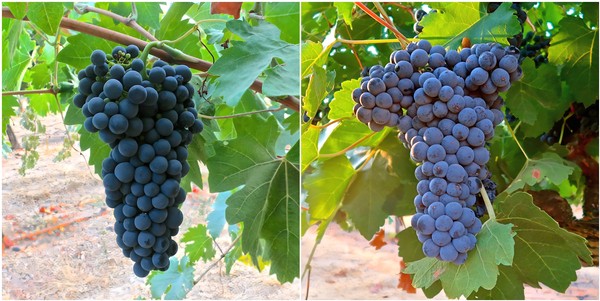
Typical cluster of Lodi grown Zinfandel (left) compared to heftier, more tightly packed Petite Sirah (right); the latter known to produce qualities that enhance the taste of Zinfandel and allowed to be blended up to 25% in varietal bottlings sold as Zinfandel.
Unless there are Petite Sirah plants grown alongside Zinfandel in a vineyard, a Zinfandel blended with Petite Sirah is less likely to express terroir-related sensory qualities. It's a Zinfandel enhanced by Petite Sirah in order to taste more like "Zinfandel" rather than a particular place.
Most commercial Zinfandels also possess perceptible qualities of "oak" because it is generally thought that the vanillin/toasty/smoky taste of barrels also enhance a wine, the same way that, say, mascara and foundation enhance a woman's face. Absolutely nothing wrong with that, of course.
However, in almost all Zinfandels crafted to express terroir, the aroma and taste of oak is restrained by the use of what vintners call "neutral" barrels⏤barrels that have been used several times before in previous vintages, thus imparting little or practically no aromas or flavors of "oak." This way, you are more likely to taste subtle qualities reflecting a vineyard or region.
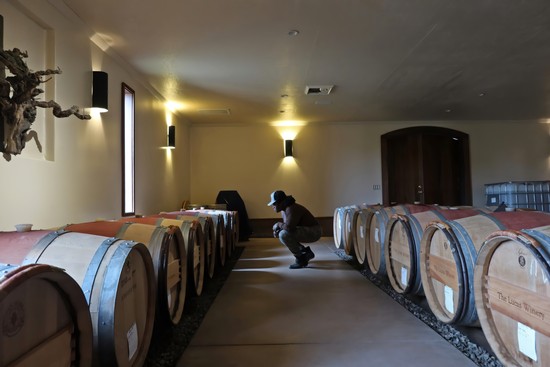
The chai (an above-ground barrel room) at Lodi's The Lucas Winery, which produces an iconic, terroir focused style of estate grown Zinfandel.
You may actually prefer an oaky style of Zinfandel, just like you prefer a woman with lots and lots of makeup. No one is saying one is better than the other. All the same, terroir focused Zinfandels usually have very subtle oak flourishes, if any at all.
The wine industry utilizes entire kits and kaboodles to make varietal wines meant to meet consumer expectations, such as selections of laboratory cultured yeasts⏤many of today's natural or terroir focused wines, on the other hand, are fermented with yeasts that grow naturally on skins of grapes⏤as well as enzymes added to fermenting wines in order to achieve specific flavor profiles. Native or "wild" yeast fermentations are very much a part of this movement towards more natural tastes.
Going even further, almost all value priced American varietal wines⏤generally speaking, wines retailing anywhere from $2 to $18/bottle⏤never see a minute in an actual oak barrel. But they still taste oaky because all a winery needs to do is steep fermentation tanks with bags of oak chips or sticks like tea bags in a cup in order to add the flavor of "oak."
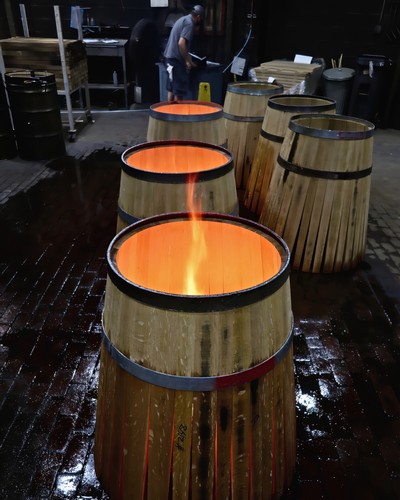
French oak coopering at Benicia, CA's Tonnelleri Ô over open fires that char the insides of barrels which can impart a smoky/toasty sensory quality to wines, especially when aged in brand new barrels.
The cost of the use of what the industry calls oak "adjuncts" is about 90% less than the cost of aging wines in actual barrels. This, in fact, is a good thing for consumers because they get the oak enriched varietal profiles they want without having to pay more than $30, $40, $50 or much more for a bottle. The only thing, again, is that this is not how most terroir focused wines are made.
The "liberation" of terroir focused wines
When it comes to varietals such as Zinfandel as well as all the other popular wines of our day (including Chardonnay, Cabernet Sauvignon, Merlot, Pinot Noir, etc.), there has been another recent movement among terroir-conscious handcraft producers: Towards the picking of grapes at a lower sugar content⏤measured in terms of Brix in the industry⏤which results in wines with lower natural alcohol and higher natural acidity. In other words, a fresher, more "natural" taste profile, which also allows the taste of a vineyard or region to be more easily perceived by the senses.
Most commercial Zinfandel, to be frank, are picked at higher sugars in order to capture the rich, ripe berry flavors associated with varietal fruitiness. But in order to lower alcohol levels to keep wines in, say, the 14.0% or 14.5% ABV range, wineries simply add water to fermenting vats or tanks. The big difference between more handcrafted terroir focused Zinfandels and more typical commercial Zinfandels is that the use of water or acidification is not usually needed. When grapes are picked at lower sugars they come out more naturally "balanced"⏤hence, more likely to taste like a vineyard or region.
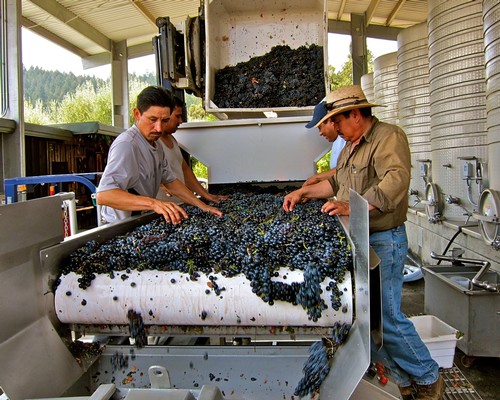
Sorting of Lodi grown old vine Zinfandel at Turley Wine Cellars, one of the industry leaders in minimal intervention, terroir focused California wines for over 30 years.
Last but not least: Because Zinfandels—and just about any other varietal—picked at lower sugars typically produce less alcohol during fermentation, the combination of lower ABV and less overt fruitiness also tends to place more emphasis on terroir-related sensory qualities (which can be subtle) in the resulting wine. One recent example: The 2023 Klinker Brick "Echoes" Zinfandel, a single-vineyard Lodi bottling finished at just 12.5% alcohol—the exact opposite of this nationally distributed brands' commercial bottlings which finish closer to 15% ABV—crafted to distinguish the wine from this particular old vine planting (called Marisa) among the hundreds of others in the Lodi appellation.
As Klinker Brick puts it, "Echoes" represents a "liberation" from "longstanding notions that Zinfandel exclusively produces robust, full-bodied wines"—a good summary of the good intentions behind the increasing number of terroir focused wines now being produced in Lodi and elsewhere around the world, from innumerable other grapes.
Our next Lodi Wine post: What is Lodi terroir? (Part 5, Where to find terroir focused Lodi wines)

Native valley oaks and old vine Zinfandel in Lodi's Mokelumne River AVA—aspects of terroir many minimal interventions style vintners now endeavor to express in bottlings.